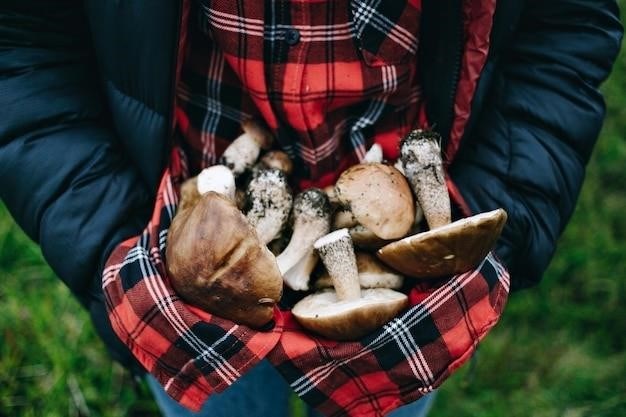
Field Guide to Mushrooms⁚ A Comprehensive Overview
Mushrooms, those fascinating and often mysterious organisms, have captivated humans for centuries. This comprehensive field guide provides a detailed exploration of the diverse world of mushrooms, covering everything from identification and foraging to cultivation and their vital role in our ecosystem.
Introduction⁚ The Fascinating World of Mushrooms
Mushrooms, those enigmatic and often overlooked organisms, are far more than just culinary delights. They are a vital part of the natural world, playing a crucial role in nutrient cycling and decomposition. Mushrooms are the fruiting bodies of fungi, complex organisms that exist in a vast, interconnected web beneath the soil. This intricate network, known as the mycelium, is responsible for breaking down dead organic matter, releasing essential nutrients back into the ecosystem. Mushrooms come in a dazzling array of shapes, sizes, and colors, each with its unique characteristics and ecological role. From the majestic giant puffball to the delicate fairy ring mushroom, the world of fungi is a captivating realm waiting to be explored.
Types of Mushrooms
The world of mushrooms is vast and diverse, encompassing a wide range of species with varying characteristics and uses. Broadly, mushrooms can be categorized into three main types⁚ edible, medicinal, and poisonous. Edible mushrooms are prized for their culinary value, adding flavor and texture to a variety of dishes. Medicinal mushrooms have been used for centuries in traditional medicine for their purported health benefits, ranging from boosting the immune system to fighting cancer. Poisonous mushrooms, on the other hand, pose a significant threat to human health and should be avoided at all costs. Understanding the different types of mushrooms is crucial for safe and responsible foraging, ensuring that only edible and medicinal varieties are consumed.
Edible Mushrooms
Edible mushrooms are a culinary delight, adding a unique flavor and texture to a wide range of dishes. From the earthy aroma of porcini to the delicate sweetness of chanterelles, edible mushrooms offer a diverse array of culinary experiences. Some popular edible mushrooms include button mushrooms, cremini mushrooms, shiitake mushrooms, oyster mushrooms, and morels. These mushrooms are commonly found in grocery stores and are often used in soups, stews, stir-fries, and pasta dishes. However, it is essential to remember that not all mushrooms are edible. Identifying edible mushrooms correctly is crucial to avoid consuming poisonous varieties that can cause severe illness or even death.
Medicinal Mushrooms
Beyond their culinary uses, certain mushrooms possess remarkable medicinal properties. These mushrooms, often referred to as “medicinal mushrooms,” have been used for centuries in traditional medicine systems worldwide. They contain unique bioactive compounds, such as polysaccharides and triterpenes, that may offer various health benefits. Some notable medicinal mushrooms include reishi, cordyceps, chaga, and lion’s mane. Reishi is known for its potential to support immune function and promote relaxation, while cordyceps is valued for its energy-boosting properties. Chaga is known for its antioxidant properties and may support overall health, while lion’s mane is believed to promote cognitive function and nerve growth. It’s important to note that while these mushrooms have shown promise in research, more studies are needed to fully understand their therapeutic potential. Always consult with a healthcare professional before using medicinal mushrooms for any health condition.
Poisonous Mushrooms
While many mushrooms are edible and even beneficial, a significant number are poisonous and can cause severe illness or even death. Identifying poisonous mushrooms requires careful observation and knowledge, as some resemble edible species. It’s crucial to avoid consuming any mushroom unless you’re absolutely certain of its identity. Some common poisonous mushrooms include the death cap (Amanita phalloides), destroying angel (Amanita virosa), and galerina (Galerina marginata). These mushrooms contain toxins that can damage the liver, kidneys, and other organs. Symptoms of mushroom poisoning can include nausea, vomiting, diarrhea, abdominal pain, and hallucinations. If you suspect you’ve consumed a poisonous mushroom, seek immediate medical attention. Remember, when in doubt, throw it out!
Identifying Mushrooms
Identifying mushrooms accurately is essential for both safety and enjoyment. It’s important to avoid relying solely on visual similarities, as many mushrooms share similar characteristics. A comprehensive approach is crucial. Start by observing the mushroom’s overall shape, size, and color. Examine the cap, gills, stem, and base for unique features like the presence of a ring or volva. Consider the habitat where the mushroom was found, as this can provide valuable clues. Using a field guide with detailed descriptions, illustrations, and identification keys is highly recommended. Remember, mushroom identification can be complex, and consulting with experienced mycologists or local mushroom clubs can be helpful. Always err on the side of caution and avoid consuming any mushroom you cannot confidently identify.
Key Features to Look For
When identifying mushrooms, focusing on key features is crucial. Observe the cap’s shape, texture, and color. Note whether the cap is smooth, scaly, or sticky. Examine the gills, which are the blade-like structures found under the cap. Are they attached to the stem, free from it, or running down the stem? Pay attention to the stem’s shape, color, and texture. Is it smooth, fibrous, or scaly? Does it have a ring or a volva, which is a cup-like structure at the base? Consider the mushroom’s overall size, its habitat, and the time of year. Documenting these details will help you use a field guide effectively and confidently identify the mushroom you’ve discovered.
Using a Field Guide
A field guide is an essential tool for mushroom identification. Look for guides specific to your region, as mushrooms vary geographically. Pay attention to the guide’s illustrations and descriptions. Compare the features of the mushroom you’ve found to those depicted in the guide. Note the color, shape, size, and texture of the cap, gills, stem, and any other distinguishing features. Read the descriptions carefully, paying attention to the mushroom’s habitat, seasonality, and edibility. Remember, always cross-reference information from multiple sources to ensure accurate identification. If you’re unsure, it’s best to consult with an experienced mushroom expert before consuming any wild mushroom.
Safety Precautions
Mushroom identification can be complex and requires careful attention to detail. Always prioritize safety when foraging for mushrooms. Never consume a wild mushroom unless you are absolutely certain of its identity. If you’re unsure, seek expert advice from a mycologist or experienced mushroom hunter. Avoid collecting mushrooms from areas that may be contaminated with pollutants or pesticides. Take note of any warning signs or regulations regarding mushroom harvesting in your area. Always carry a field guide, a camera for documentation, and a basket for collecting. Be mindful of your surroundings and leave the environment undisturbed. Respect the natural habitat of mushrooms and avoid overharvesting.
Mushroom Hunting
Mushroom hunting, or foraging, can be an enjoyable and rewarding experience, connecting you with nature and providing a delicious source of food. To embark on a successful mushroom hunt, choosing the right location is paramount. Look for areas with diverse vegetation, damp soil, and plenty of decaying wood, as these are ideal habitats for mushrooms. The best time of year for mushroom hunting varies depending on the species and your geographic location. Consult field guides and local experts to determine the peak season for your desired mushrooms. Remember to practice ethical considerations while foraging. Only harvest what you need and leave some for others and for the ecosystem. Be respectful of the environment and avoid disturbing fragile habitats.
Choosing the Right Location
When venturing into the world of mushroom hunting, selecting the right location is crucial for a successful and safe experience. Look for areas with diverse vegetation, as different mushroom species thrive in specific environments. Forests with a mix of trees, such as oak, maple, and pine, are often excellent starting points. Damp soil is another key indicator, as many mushrooms require moisture to flourish. Areas near streams, rivers, or ponds are particularly promising. Furthermore, pay attention to the presence of decaying wood, such as logs and stumps, as many mushrooms are saprophytic, meaning they feed on dead organic matter. These areas provide a rich habitat for a variety of mushroom species.
Best Time of Year for Mushroom Hunting
The optimal time for mushroom hunting varies depending on the specific species you’re seeking. Generally, spring and fall offer the most abundant and diverse harvests. As temperatures begin to warm in spring, many mushrooms emerge from the soil, taking advantage of the increased moisture and sunlight. Fall, with its cooler temperatures and frequent rainfall, provides another ideal window for mushroom growth. However, it’s important to note that certain species, like morels, prefer warmer temperatures and may appear earlier in the spring. Summer, while not as prolific, can still yield some mushrooms, especially in areas with consistently moist conditions. It’s always a good idea to consult local field guides and mushroom experts to pinpoint the prime time for specific species in your region.
Ethical Considerations
Mushroom hunting is a rewarding and enjoyable activity, but it’s crucial to approach it with respect for the environment and the fungal community. Always practice sustainable harvesting techniques, taking only what you need and leaving plenty behind for other foragers and to ensure the continuation of future generations. Avoid disturbing the surrounding vegetation and refrain from digging up entire colonies. Furthermore, be mindful of rare or endangered species, and never harvest from protected areas or private property without permission. It’s essential to educate yourself about local regulations and guidelines to ensure responsible mushroom hunting practices.
Mushroom Cultivation
Cultivating mushrooms at home can be a rewarding and delicious endeavor. With the right conditions and materials, you can enjoy fresh, homegrown mushrooms throughout the year. There are various methods for cultivating mushrooms, from simple kits to more elaborate setups. Popular choices for home cultivation include oyster mushrooms, shiitake mushrooms, and button mushrooms. These mushrooms thrive in a controlled environment with proper humidity, temperature, and substrate. Commercial mushroom farming involves larger-scale operations, utilizing advanced techniques and specialized equipment to produce vast quantities of mushrooms for the market. The demand for cultivated mushrooms continues to rise, highlighting the growing importance of this agricultural practice.
Growing Mushrooms at Home
Cultivating mushrooms at home can be a rewarding and delicious endeavor. With the right conditions and materials, you can enjoy fresh, homegrown mushrooms throughout the year. There are various methods for cultivating mushrooms, from simple kits to more elaborate setups. Popular choices for home cultivation include oyster mushrooms, shiitake mushrooms, and button mushrooms. These mushrooms thrive in a controlled environment with proper humidity, temperature, and substrate. You can purchase mushroom growing kits online or at garden centers, or create your own using readily available materials. With a little patience and effort, you can enjoy the satisfaction of harvesting your own delectable mushrooms.
Commercial Mushroom Farming
Commercial mushroom farming is a sophisticated industry that provides a consistent supply of fresh mushrooms to consumers worldwide. Large-scale mushroom farms utilize controlled environments to optimize growth conditions. These farms employ specialized techniques for substrate preparation, inoculation, and harvesting. The most common commercially grown mushrooms are button mushrooms, cremini mushrooms, portobello mushrooms, and oyster mushrooms. These mushrooms are cultivated on a massive scale, with farms carefully controlling factors such as temperature, humidity, and ventilation. Commercial mushroom farming relies on advanced technology and careful management to ensure consistent quality and yield, meeting the demand for these popular culinary ingredients.
The Importance of Mushroom Knowledge

Understanding the world of mushrooms is essential for both safety and appreciation. Identifying edible mushrooms correctly is crucial to prevent accidental poisoning, while recognizing poisonous varieties helps avoid dangerous encounters. Furthermore, knowledge about mushrooms allows us to appreciate their diverse roles in nature, from decomposing organic matter to forming symbiotic relationships with trees. By cultivating a deeper understanding of these fascinating organisms, we can foster a greater appreciation for the intricate web of life and make informed decisions about our interactions with the natural world. The field guide to mushrooms serves as a valuable resource, empowering individuals to explore the fascinating world of fungi with confidence and knowledge.



